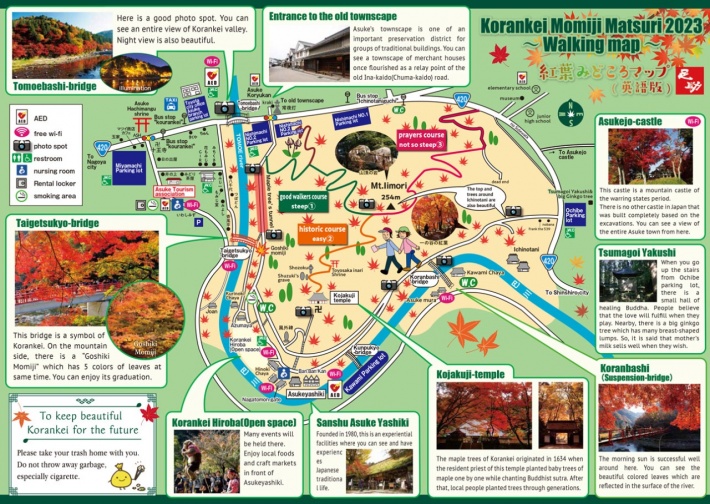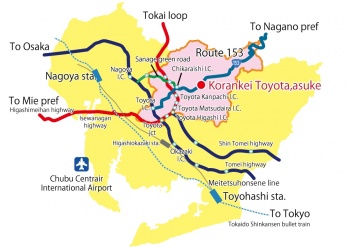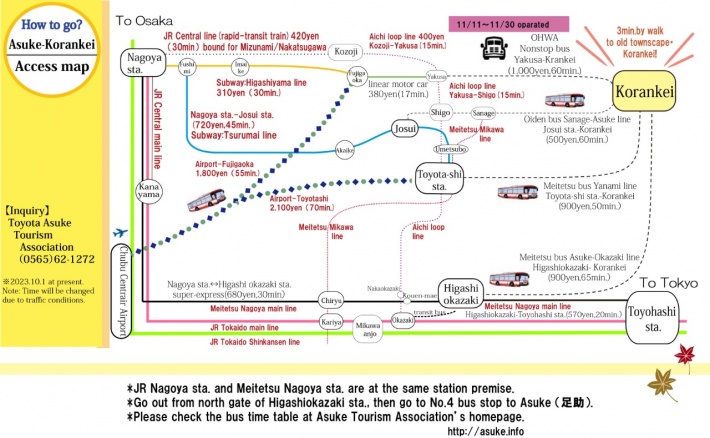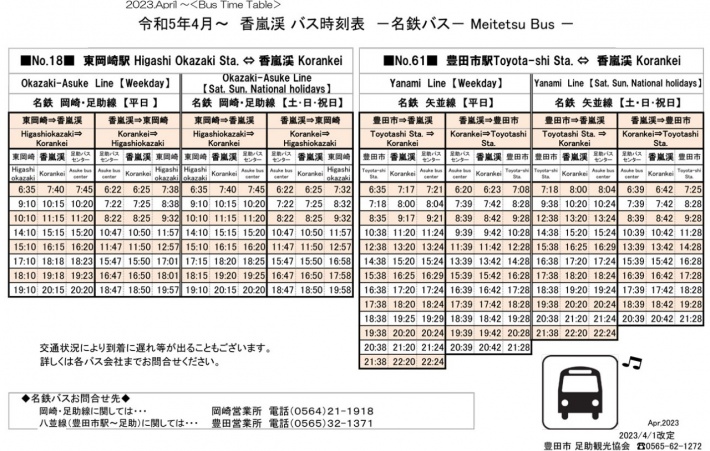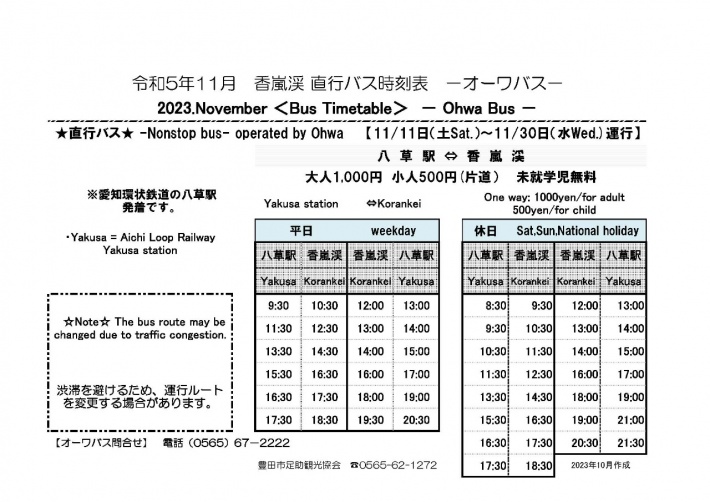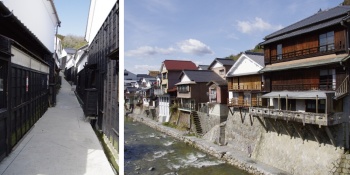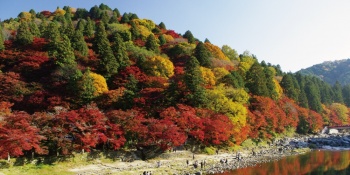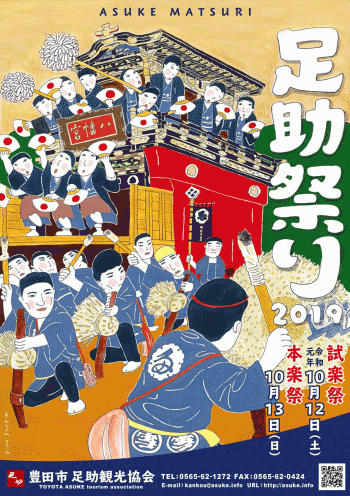
Information about ASUKE!!
Korankei Momiji Matsuri 2023 ~Walking map~
紅葉みどころマップ(英語版)
Information about transit access
[By car]
[From Nagoya and Osaka]
Approx. 14min(10km) eastwards from Toyota-kanpachi(豊田勘八) I.C. of the Tokai Loop Expressway via Route 153(access from Toyota JCT of the Higashi-meihan or Isewangan expressway.
[From Tokyo]
Approx. 19min(13km) eastwards from Toyota-kanpachi(豊田勘八) I.C. of the Tokai Loop Expressway via routes 153 (access from Toyota JCT of the Tomei or Shin-Tomei expressway).
※Please use toll parking of Korankei park.
[By train]
・Take the subway Tsurumai line to Josui(浄水) station, and take the Toyota Oiden Bus Sanage-Asuke Line (さなげ・足助線 Sanage-Asuke-sen, bound for 百年草 Hyakunenso), get off at Korankei (香嵐渓) and walk 3min.
Bus fee ¥500, ride time 60min.
・Get off Toyotashi station of Meitetsumikawa line, take the Meitetsu bus Yanami line(矢並線) bound for Asuke terminal. Bus fee\¥900, ride time 40min.
・Get off Higashi-okazaki(東岡崎)station of Meitetsunagoya line, take the Meitetsu bus Okazaki-Asuke line bound for Asuke terminal. Bus fee\¥900, ride time 70minl.
※To Higashi-okazaki-station, the last bus leaves at 18:50 on weedday, at 15:50 on weekend.
Please check the bus time table carefully.

Oiden bus
Nonstop bus Time Table 2023 operated by Ohwa bus
※Attention!
OHWA bus root operated during Korankei Momiji Matsuri(maple festival) on November.
Spot
Asuke Townscape
The streets of Asuke were an important transfer point of the Ina Kaido Road (Chuma Kaido Road) that connected the Mikawa region of the Owari Province to the Shinano Province and Asuke was a merchant town that prospered as an important place for the transportation of goods. Many houses that were built in Asuke in the latter half of the Edo period (from 1776 to 1830) still remain today. In 2011, the Asuke streets became the first area from Aichi Prefecture to be selected as an Important Preservation District for Groups of Traditional Buildings.
Asuke Hachimangu Shrine and Asuke Shrine
It is said that the Asuke Hachimangu Shrine answers the prayers of people for healthier feet. This is because Asuke used to be a crossroads where people could rest their feet. The shrine provides amulets for healthier feet and written oracles called omikuji. The main chamber of the shrine is a national important cultural asset.
The Asuke Shrine worships Mr. Asuke Jiro Shigenori who was a very skillful archer. Lord Shigenori played an important part in guarding Emperor Godaigo in the "Genko Incident" as a military commander-in-chief of an army of 3,000 soldiers.
Kojakuji Temple
The Kojakuji Temple is an ancient temple of the Soto school of Zen Buddhism that was established in 1427 in the remains of the Asuke family residence, the castle lords of "Hanseizan."
The group of maple trees of the Korankei Gorge originated from one maple tree that was planted in 1634 by a Buddhist priest named Sanei, the 11th successor of the temple. The temple provides written oracles called omikuji.
Asuke Castle
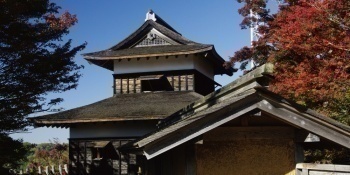
The Asuke Castle was built by the Suzuki family who ruled the Asuke Region during the Age of Civil Wars. The castle was restored based on excavational investigation. The restoration of a mountaintop castle is extremely rare in Japan.
From the mountaintop donjon that is 307 meters above sea level, you can see the beautiful townscape of Asuke. It takes about 40 minutes on foot to get to the castle.
Phone: 0565-62-0770 (+81-565-62-0770 from abroad) Holiday: Thursday
Sanshu Asuke Yashiki (Sanshu Asuke residence)
Sanshu Asuke Yashiki is an interactive facility where you can experience olden-day life in the mountains including trying handwork such as handloom-weaving and indigo-dyeing. The facility has a dining hall where you can enjoy delicious mountain village food such as Gohei-mochi (skewered sweet rice cakes served with soy sauce and miso) and grilled ayu fish (sweetfish) seasoned with salt.
It takes about 10 minutes by foot to get to the temple. Phone: 0565-62-1188 (+81-565-62-1188 from abroad) Holiday: Thursday
Korankei Gorge
Korankei Gorge is the most famous place for autumn leaves in the Tokai Region. In November, the leaves of about four thousand maple trees turn red all at once, making for a picturesque view of the gorge. In May, the fresh, new leaves aren't to be missed, and in March, pale purple dog's tooth violet flowers bloom throughout the gorge, making it a place where you can enjoy the Japanese seasonal changes.
Asuke Matsuri~Japanese traditional Matsuri festival~
ASUKE MATSURI
■Asuke Hachimangu shrine■
Asuke Hachimangu Shrine is known for that it answers the prayers of people for healthier feet. This is because Asuke used to be an important stopover place where people could rest their feet. The main chamber of the shrine is a National Important Cultural Property. People can buy healthy feet amulets and un unique foot-shape votive tablet in the shrine.
■Asuke Matsuri■
The Asuke Matsuri is an annual autumn festival of Asuke Hachimangu Shrine.
It is held on the 2nd Sunday and the day before in October every year.
They keep the traditional style of the festival which has been continued since the middle of 1700’s.
On Saturday morning, the separated parts of the festival floats are built up by men. Then 4 festival floats start to parade inside each town area at 2p.m. After that, the Mikoshi a portable shrine will start to parade at 6p.m. Matchlock gun teams will fire up(blank shot) outside the shrine. There are 11 gun teams in Asuke now.
There are more than 200 gun shooters gather in this festival. These gun teams originally exist to guard their horse to dedicated to the god of a shrine. ※Matchlock gun= a gun introduced from Portuguese.
On Sunday, the floats are pulled out from each town toward the shrine.
People can watch hundreds of gun shooting in the Asuke Hachimangu shrine area,
Bounote (the military art) with wooden weapons, and listen to the traditional Japanese
instrumental music. When the night comes, the 4 festival floats which are decorated with
many lanterns across the Tomoebashi bridge and go back to each town.
■Highlight■
On Sunday at 10a.m., when the festival floats gather and enter the shrine, the young men holding fans are dancing on the front stage of the floats. They comically lean to the right and left and call out “Osa-Osa”.
On Sunday at 6p.m., a leader of young man gives a congratulatory, then throw away the secret baton with white Japanese paper called “Bonten”. Everybody wants to catch it because the god give a good luck and the safety of their family to the catcher. Also, festival floats which are decorated with lantern are very beautiful and attractive.
■Dashi of Asuke-festival float■
Height 6.3~6.6 meters(20’8” – 21’8” inches), Weight 4 tons.
There are 4 stories. The 1st floor is for “Ohayashi” music players, the 2nd floor is for dancers,
and the 3rd floor is for Buddhist alters. A wooden float decorated with gorgeous embroidery and
engraving arts. Dozens of villagers wearing traditional costume pull it with 8 ropes.
It is very unique because there is a front stage. Now young men are dancing on stage,
but in the old days, they had the Kabuki play instead.
■Mikoshi of Asuke-portable shirine■
The shrine god is carried around the town in its portable mikoshi. It’s like a one of catering service by the shrine.
People can wish to get the bless from the god for safety and health without visiting the shrine. The young people who are selected to carry the mikoshi must be born in Miyamachi where the shrine is located.
Issued by TOYOTA ASUKE tourism association http://asuke.info

